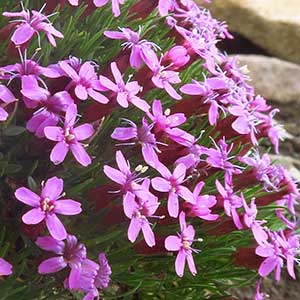Silene acaulis
Caryophyllaceae subfam. caryophylloideae
moss campion, silène acaule
erect or ascending, seldom sprawling, decumbent, or prostrate, simple or branched.
erect, leafy proximally, 3–6(–15) cm, old leaves persistent at base.
mostly basal, densely crowded and imbricate, sessile;
blade 1(–3)-veined, linear-subulate to lanceolate, 0.4–1(–1.5) cm × 0.8–1.5(–2) mm, margins cartilaginous, often ciliolate especially proximally, apex acute, glabrous to scabrous.
opposite, rarely whorled, connate proximally, petiolate (basal leaves) or often sessile, not stipulate;
blade linear or subulate to ovate, not succulent or rarely so (Silene).
solitary flowers.
terminal cymes, thyrses, fascicles, or capitula, or flowers solitary, axillary;
bracts foliaceous, scarious, or absent;
involucel bracteoles present or often absent.
2–40 mm.
present or rarely flowers sessile or subsessile.
bisexual or unisexual, all plants having both staminate and pistillate flowers, others having only pistillate flowers, subsessile or borne singly on peduncle;
calyx 10-veined, lateral veins absent, tubular to campanulate, (5–)7–10 mm, herbaceous, margins often purple tinged, dentate, sometimes ciliate, ± scarious, glabrous, lobes lanceolate to ovate, 1–2 mm;
petals bright pink, rarely white, limb unlobed to shallowly 2-fid, 2.5–3.5 mm, base tapered into claw, auricles and appendages poorly developed;
stamens exserted in staminate flowers, not so or aborted in pistillate flowers;
styles 3.
bisexual or seldom unisexual (the species then often dioecious), often conspicuous;
perianth and androecium hypogynous;
sepals 5, connate (1/4–)1/2+ their lengths into cup or tube, (1–)5–40(–62) mm, apex not hooded or awned;
petals absent or 5, often showy, white to pink or red, usually clawed, auricles absent or sometimes present, coronal appendages sometimes present, blade apex entire or emarginate to 2-fid, sometimes dentate to lacinate;
stamens (5 or) 10 (absent in pistillate flowers), in 1 or 2 whorls, arising from base of ovary;
staminodes absent or rarely 1–10;
ovary 1-locular, sometimes 2-locular proximally (Vaccaria), or 3–5-locular (some Silene);
styles 2–3(–5) (absent in staminate flowers), distinct;
stigmas 2–3(–5) (absent in staminate flowers).
capsules, opening by 4–6(–10) valves or teeth;
carpophore usually present.
3-locular, cylindric, equaling or to 2 times calyx, opening by 6 recurved teeth;
carpophore ca. 1 mm.
light brown, reniform, 0.8–1(–1.2) mm broad, dull, shallowly rugose.
4–150(–500+), reddish to gray or often brown or black, usually reniform and laterally compressed to globose, sometimes oblong or shield-shaped and dorsiventrally compressed;
embryo peripheral and curved, or central and straight.
= 7, 10, 12, [13?,] 14, 15, 17, [18].
= 24.
Silene acaulis
Caryophyllaceae subfam. caryophylloideae
Silene acaulis is a variable species, and most workers have recognized infraspecific taxa in North America: subsp. acaulis (subsp. exscapa and subsp. arctica), which is predominantly arctic; and subsp. subacaulescens, which extends down the Rocky Mountains from Alaska to Arizona and New Mexico. In subsp. acaulis, the leaves are flat and short and the flowers are subsessile and smaller in size. Subspecies subacaulescens is typically a larger, less-compact plant with longer, narrower leaves and larger, pedunculate flowers. However, in many populations, these two variants are poorly differentiated, and in others both occur together, connected by intermediates.
Silene acaulis is widely distributed in arctic and alpine Europe.
(Discussion copyrighted by Flora of North America; reprinted with permission.)
Genera 20 or 26, species ca. 1500 (8 genera, 89 species in the flora).
Caryophylloideae can be characterized by the presence of sepals connate into a cup or (usually) long tube, clawed petals (often with appendages and auricles), and a lack of stipules. The largest genera in the family [Silene (incl. Lychnis), about 700 species; Dianthus, about 320 species] are in the Caryophylloideae; together with Gypsophila (about 150 species), these three genera include about three-quarters of the species found in the family. Three tribes are often differentiated on calyx venation and number of styles, with two, Caryophylleae and Sileneae, incorporating nearly all of the genera.
Caryophylloideae share the caryophyllad type of embryogeny with Alsinoideae and, as postulated by V. Bittrich (1993), the two may form a monophyletic group. Results from preliminary molecular studies by M. Nepokroeff et al. (2002) and R. D. Smissen et al. (2002) reinforce that hypothesis, but the relationships among members of the two subfamilies remain unclear.
Most of the molecular work within the subfamily has focused on Sileneae and more specifically on trying to determine whether or not Silene is monophyletic.
(Discussion copyrighted by Flora of North America; reprinted with permission.)


